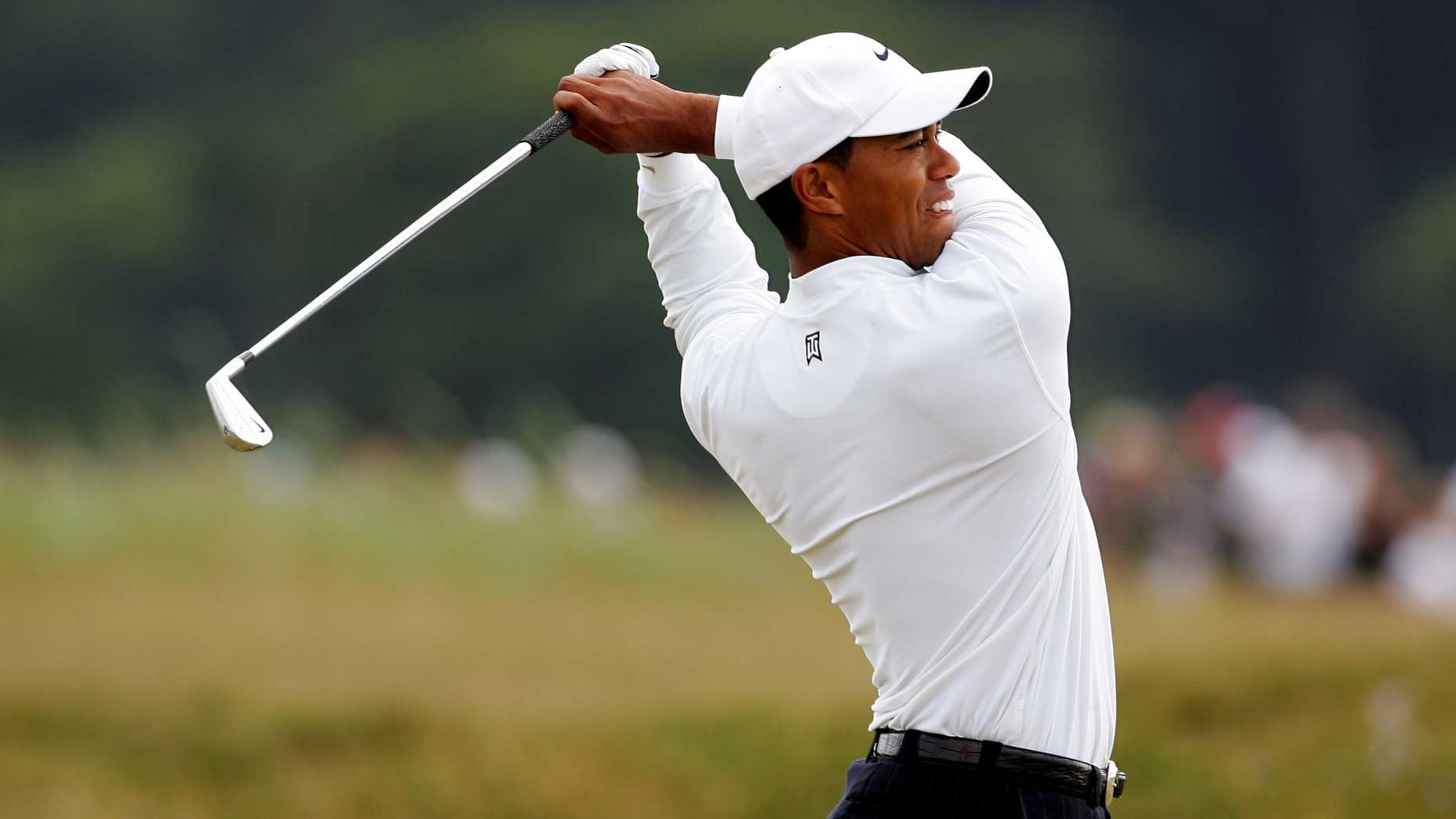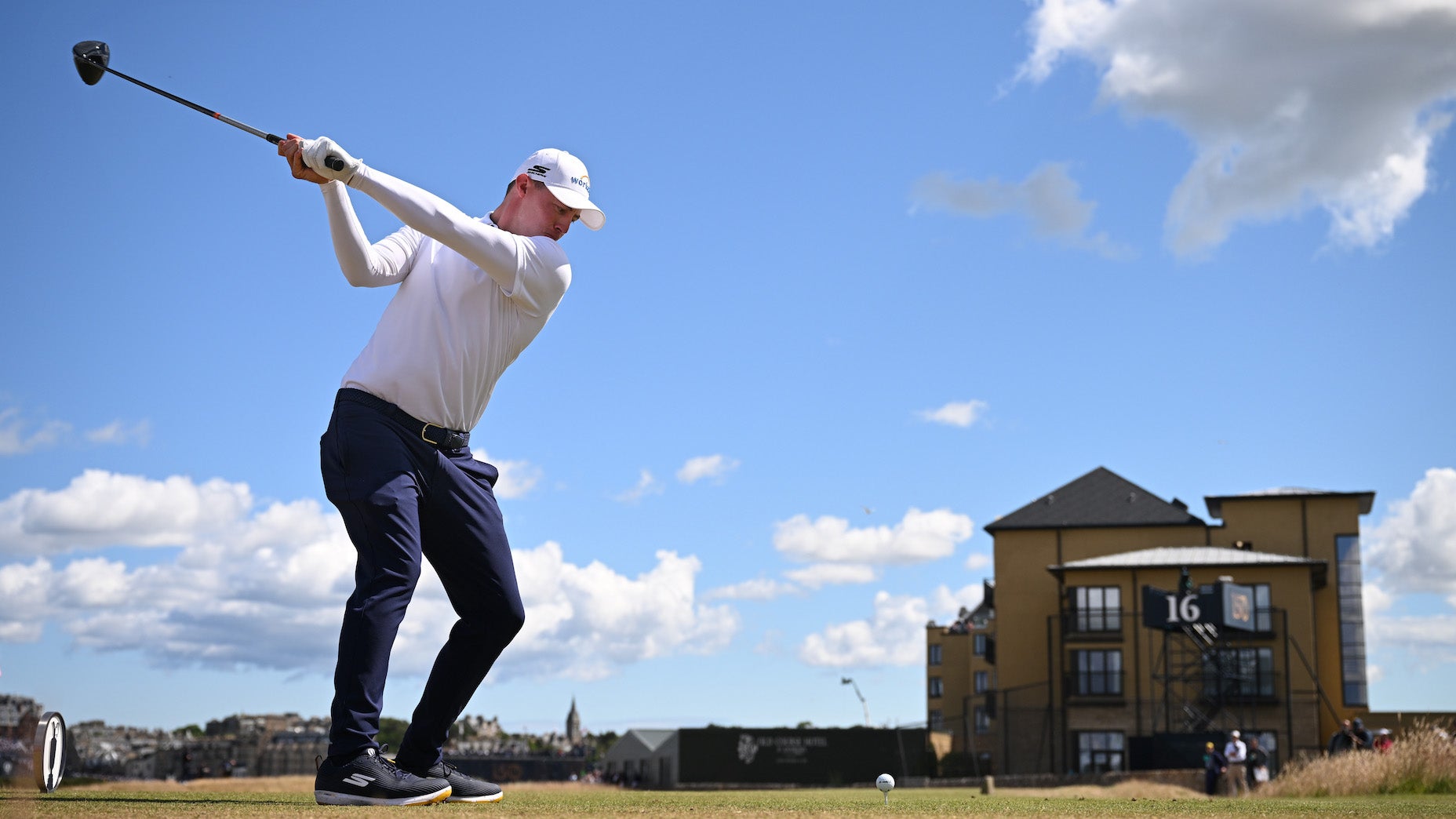
Tiger Woods on the 18th hole at St. Andrews.
Getty Images
ST. ANDREWS, Scotland — Everything ends badly. Otherwise it wouldn’t end.
Tiger Woods stood on the 18th tee at St. Andrews, mulling his options. The hole location was cut close to the front edge, just over the Valley of Sin, just under 350 yards away. He tossed some grass into the air, testing the wind. He wondered: 3-wood or 5-wood?
He chose 3-wood and stared into space, waiting for the green to clear.
(I stood to the side, mulling over the above quote from noted philosopher Tom Cruise.)
Fans streamed in from every corner of the property, magnetically attracted to the scene. Moths to a flame. The sun had emerged, turning a dreary morning into a Scottish summer dream. Soft-serves dripped dangerously down their cones while their distracted owners strained for a better view.
Woods gazed towards the green. He wore a long-sleeved white mock-neck under a white sweater vest. His fashion has evolved over the years, but some staples have endured. When he plays the Open, he likes a long-sleeve mock and loves a sweater vest. Woods’ love of history even extends sartorially; his outfits don’t repeat but they do echo. This year’s Friday look mirrored his getup from Saturday in 2005, another year the Open was at St. Andrews. Woods wore a white mock-neck on Saturday and shot 71 to open up a two-shot lead. The next day he wore a red shirt and won by 5.

Tiger Woods at the Open Championship in 2005.
Getty Images
He won’t get to wear red this year. Not at the Old Course, at least. Woods’ Open Championship got off to a horrific start when he found a divot on the first fairway on Thursday, fluffed his approach into the Swilcan Burn, missed a four-foot putt and made double bogey. It never got much better after that. Woods stumbled to a first-round six-over 78.
On Friday, he knew he’d need about 66 to make the cut and gave a glimmer of hope with a birdie at the par-4 third. But he missed a short par putt at 4, made a disappointing par at the par-5 fifth and made another bogey at No. 6, all but eliminating his chance at the weekend.
He made pars the rest of the way save for one double bogey, a deflating scene at 16 where his flop shot trickled back into a pot bunker. He came to the 18th tee at nine over par, beating just a half-dozen players. After triumphant runs at the cut line at the Masters and PGA Championship, Woods optimists had circled this week as the event where he’d actually contend. Our expectations had unfairly inflated, but the fact that his tournament had gone this poorly was disappointing and surprising. Still, none of that seemed to matter by the time he reached 18.
Matthew Fitzpatrick was first to play. He was on a heater, making seven birdies against just a single bogey. Growing up in England, Woods was his golfing idol. Since turning pro, he has seen Woods at his worst and at his best. When the two first played together at the Dubai Desert Classic in 2017, Woods withdrew after one round; it would be the better part of a year before he played again. They played again at the Players Championship in 2019; Woods played well in a final-round three-under 69. A month later he won the Masters.
Here at the Open, Fitzpatrick had built a 15-shot lead over his childhood hero through 35 holes. His tee shot found the fairway and trickled up just shy of the green.
Max Homa was next on the tee. He grew up a Woods disciple, too, a kid from Southern California with PGA Tour dreams. Homa has never been shy about his Tiger Woods fanhood. His professional career’s greatest moment came when he won his hometown event — the 2021 Genesis Invitational at Riviera — and Woods was there to hand him the trophy. But the two had never played together until this week, which Homa called “a dream come true.” You could forgive Homa, No. 19 in the world, if he found himself somewhat off his game. Now he stood on the 18th tee at two over par, needing eagle to make the cut on the number. He found the fairway, too.
Woods chose 3-wood. Worried it was too much club, he took something off — just a chip, he said — and hit just the shot he’d envisioned. It was pummeled down the fairway. His ball threatened the front edge of the green but rolled just off the left side.
And then Woods began the walk.
Homa and Fitzpatrick, sensing the moment, hung to the side. So did the caddies. Woods, still holding 3-wood, looked for caddie Joe LaCava.
“I felt the guys stop, and I looked around — where the hell is Joey? He stopped back there, so I gave him the club,” Woods said afterward in an emotional address to a packed house of media members. “That’s when I started to realize, hey, the next time it comes around here I might not be around.”
It’s not the first time Woods has considered this possibility. He’d mentioned earlier in the week just how meaningful this trip to St. Andrews would be, knowing it could be his last trip as a serious competitor. But suddenly here he was, playing his final hole of the tournament at his favorite golf course.
There had been some early-week speculation that Woods would pause on the iconic Swilcan Bridge for a photo op, taking the chance to thank the crowd for decades of adoration. Down the right side of 18, ticketed spectators jostled for position, five and six and 10 people deep. On the public street behind them, the general public queued up against the fence on their tiptoes for a better view.
Woods took off his hat as he approached the bridge. He waved to the crowd on his way over. He slowed down. But he didn’t stop. It was perfectly representative of Woods’ place in the competitive golf world — in the twilight of his career, but certainly not done. He could be back. He could be.
In 1995, his first tournament at St. Andrews, Woods watched Arnold Palmer play his final tee shot. In 2000, Woods witnessed Jack Nicklaus’ final trip ’round the Old Course. Woods is keenly aware of the passage of time, now more than ever. As the ovation continued, it was only fitting that Rory McIlroy, the greatest player of the next generation, had just teed off No. 1. McIlroy walked up their shared fairway, gazing over at Woods and grinning at his reception.
“He gave me the tip of the cap,” Woods said. “The nods I was getting from guys as they were going out and I was coming in, just the respect, that was pretty neat. And from a players’ fraternity level, it’s neat to see that and feel that.”
The crowd grew louder as Woods drew closer to the green and closer to the bleachers enclosing it. “It felt like the whole tournament was right there,” Wood said. “And they all had appreciated what I’ve done here for the years I’ve played — I’ve won two championships here — my British Open success and all my times I’ve enjoyed here in Scotland and playing, I felt like it just came to a head right there as I was walking to my golf ball.”
A tear appeared on Woods’ cheek. He doesn’t cry often, he said. But this hit him hard.
“Life moves on. And I think that’s what people understand,” he said. Opens only come here every five years, which means even the greats only get so many cracks at St. Andrews. None have taken better advantage than Woods.
Homa played his chip to the front of the green; Fitzpatrick did the same. Woods pulled 4-iron from his bag and rehearsed the exact shot he’d practiced all week: A low, skittering 4-iron through the Valley of Sin that would trickle up onto the green and die at the hole. He and Justin Thomas, his adopted “little brother,” were here six days before, chipping balls around the 18th green in front of 100 people, playing with the slopes and enjoying the process. Perfect timing: there was Thomas, gazing over from the first tee. Woods played the shot to absolute perfection, rolling his Bridgestone up the slope and over the hump, where it settled just right of the hole, four feet away. It had never left the ground.
Fitzpatrick just missed his birdie putt. Homa made his and practically ran off the green, clearing the stage. Woods studied his four-footer from both sides. The putt was completely inconsequential, the difference between eight over par and nine over par. Except, of course, for the fact it was struck by Tiger Woods, who doesn’t have an “inconsequential” gear.
But this week, Woods didn’t have his putter in gear, either. He took two practice strokes. He stepped up to the ball. And he missed the putt, his ball catching the lip and spinning out. The crowd sagged. Woods shook his head. He walked around the hole. He tapped in. As he fished the ball out of the cup, he couldn’t resist looking at the putt again, wondering where it had gone wrong.
Everything ends badly. But is this the end? We don’t know.
We don’t know when the Open will return to St. Andrews; Woods alluded to a 2030 date, though the R&A has only confirmed sites through 2025. That sounds, to him, like a long time from now. He has nothing on his schedule. No plans to play. If you’re looking for a silver lining, Woods moved better this week than he had at Augusta or Southern Hills. But if you’re a realist, he was clearly rusty. One reporter asked if he’ll consider playing more tournaments before next year’s majors. Woods could only laugh.
“I understand being more battle-hardened, but it’s hard just to walk and play 18 holes,” he said. “People have no idea what I have to go through and the hours of work on the body, pre- and post-[round], each and every single day, to do what I just did.”
Woods has joked about being Humpty Dumpty. The implication is clear: he can only get broken down and glued together so many times. There were plenty of players older than Woods ahead of him on the leaderboard. Forty-nine-year-old Lee Westwood was well inside the cut line, while 50-year-old Padraig Harrington, 52-year-old Ernie Els and 56-year-old John Daly just missed. In this sport, especially at this tournament, age doesn’t mean what it does elsewhere. But Woods and his body have been through things the others haven’t.
Woods turned to the crowd for a final wave. He shook hands with Homa, then with Fitzpatrick, who he wished well for the weekend. He embraced Billy Foster, Fitzpatrick’s caddie and Woods’ longtime friend. He gave LaCava a bear hug. His small-knit team awaited: his right-hand man, Rob McNamara, his agent Mark Steinberg, his girlfriend Erica Herman. They’d disappear into the afternoon.
As soon as Woods was ready.








